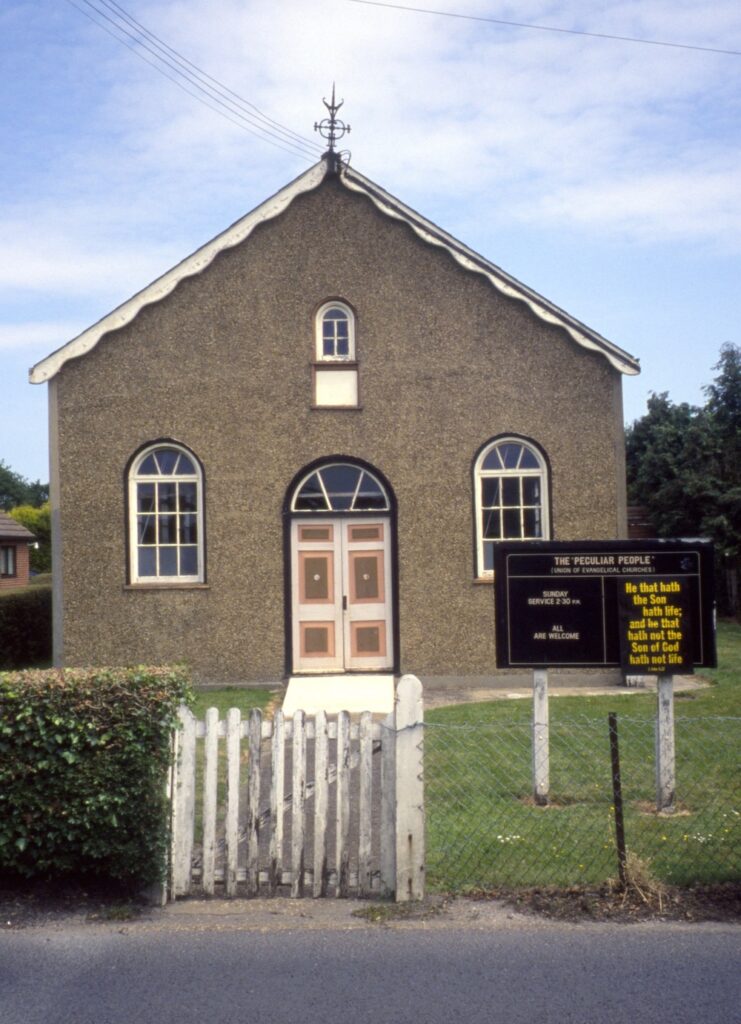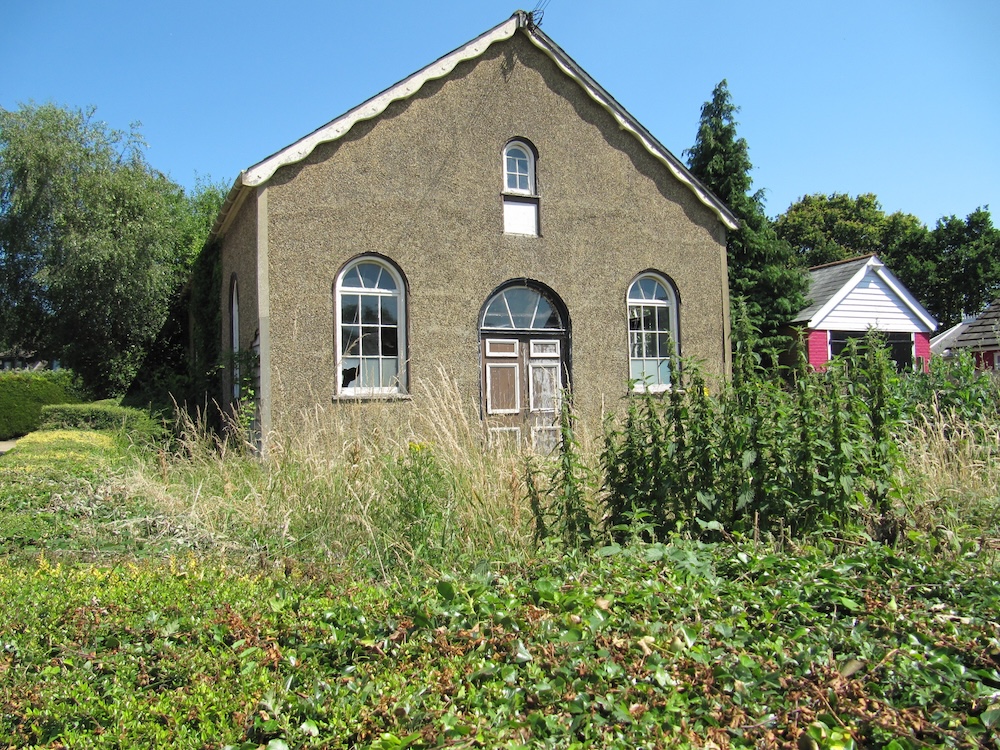Newly published by Little Toller, Ken Worpole’s ‘Brightening From the East: Essays on Landscape and Memory’ tells stories of arcadian dreams among the shabby plotlands of eastern England. It’s also our Book of the Month for April. Read an extract below.

In the early 1960s my family lived for a short time in Daws Heath, a small settlement near Southend, renting a house across the road from a chapel belonging to The Peculiar People, a Nonconformist sect unique to Essex. On Sundays and sometimes during the week we would hear stirring hymns emanating from the small, four-square chapel, but otherwise chapel life didn’t intrude into our lives, neither did the activities or beliefs of the congregations of the Elim Pentecostal Church in nearby Hadleigh, which also counted a Baptist Chapel and a Methodist Church (as well as the Norman Anglican church of St James the Lesser, where for a while I sang in the choir). The ‘low’ churches – as they were often termed – were still quite active at the time across the county, dissent and Nonconformism being particularly strong in East Anglia where, in the words of the Anglican preacher and writer, Ronald Blythe, ‘even the wind was doctrinal’.
Writer Philip Hoare mentions the Peculiars in England’s Lost Eden: Adventures in a Victorian Utopia (2005), his study of early Victorian religious enthusiasm, though he refers only to the ‘Plumstead Peculiars’, one of only two branches outside Essex. At its height the Peculiars had more than 50 chapels in Essex, originating in Rochford in the 1830s as the result of the religious epiphany experienced by local farm labourer, James Banyard, whose life until then had been decidedly drunken and quarrelsome. Banyard was first a Wesleyan before establishing his own sect.
The full story is told in Mark Sorrell’s history, The Peculiar People (1979), since supplemented by newer archive material and recollections, including those of novelist Bernard Cornwell on Desert Island Discs in 2004, where he recalled his early life as the adopted son of a Peculiar family. In his own words, Cornwell’s childhood memories were ‘very ugly’. No television, cinema, comics, unsuitable books or music, with the threat of eternal damnation hung over all those who failed to convert. On one occasion he was with his father in Rayleigh High Street when they passed by the memorial to four Protestant martyrs burned at the stake in 1555. Cornwell’s adoptive father said that he himself expected to be martyred one day. In the chapel the family attended was a ‘mercy seat’, where the as yet unconverted could sit and await the divine call. At the age of sixteen the would-be novelist walked out of the house one day and never returned.
Cornwell disliked the Peculiars from direct experience, though in general members were tolerated by outsiders – except when it came to the issue of divine healing. Like the Plymouth Brethren, the Peculiars eschewed the use of doctors or any form of medical intervention, preferring the healing power of prayer. When this involved cases of children (especially of those very seriously ill), public opinion, and the law, took against them. This matter also led to the first of several doctrinal schisms, when Banyard’s own son became seriously ill and after agonizing at length a doctor was called in, causing a church split. In the twentieth-century, distrust arose for another reason, as the pacifist beliefs the sect led to many being imprisoned as conscientious objectors, a position regarded as virtually unforgiveable during the First World War, less so during World War Two.
While it is hard to warm to the severity of the ‘assemblies of Brethren’ such as the Essex Peculiars, there is at least one episode in their history counting strongly in their favour. Two other sects related to the Peculiars were active in the same period, arising out of the unyielding proselytising of the Anglo-Irish preacher John Nelson Darby. Born in 1800, and original instigator behind the Brethren sects, Darby established the Plymouth Brethren in the 1830s, that sect itself soon dividing into the ‘Open Brethren’ and the ‘Exclusive Brethren’, the latter congregation under Darby’s leadership. A tireless traveller and speaker across Britain and Europe, Darby also established congregations in North America and Australia. Unable to prevent the Exclusives dividing yet again, in 1890 another breakaway group emerged under the leadership of Frederick Edward Raven, their respective followers becoming known as ‘the Darbyists’ and ‘the Ravenists’, the latter most closely associated with the Essex brethren.
Both the Darbyists and the Ravenists established rival outposts in France at the end of the 19th century, on the mountainous Plateau-Vivarais-Lignon in the French Massif-Central, a bolt-hole for other Protestant congregations. According to historian Caroline Moorehead’s account in Village of Secrets: Defying the Nazis in Vichy France, it was here that both groups ‘settled into parallel lives of quiet piety’. Then came the Second World War and the Nazi occupation of France, and it was then that both sects acquitted themselves with honour, sheltering and protecting hundreds of Jewish children in their mountain retreats at considerable danger to themselves. The two small religious communities saved at least 800 children’s lives according to Moorehead, who concluded that: ‘In these communes and isolated farmhouses, more people, proportionately, were saved than anywhere else in France.’
The last time I cycled through Tillingham on the Dengie Marshes, I noticed the Peculiar Chapel closed and semi-derelict; elsewhere others have been demolished. This is the ‘gaunt tabernacle on the village’s single street’ that Jonathan Raban warmed to in Coasting, his atmospheric account of sailing round Britain. He wrote that, ‘They were indeed a peculiar people, living at an oblique angle to the rest of England, so far out on the country’s watery margin that they had almost run away to sea.’ The loss of these smaller, often modest workaday religious buildings, which anchored so many Essex towns and villages in a long tradition of Nonconformist life and culture, is cause for concern. One does not have to be a religious revivalist or antiquarian to regret the way in which the many traces of public memory embodied in these buildings are being erased from the landscape and townscape, and with them the beliefs and aspirations they embodied, however unworldly they seem to us today.

*
‘Brightening from the East: Essays on Landscape and Memory’ is out now and available here (£15.20).